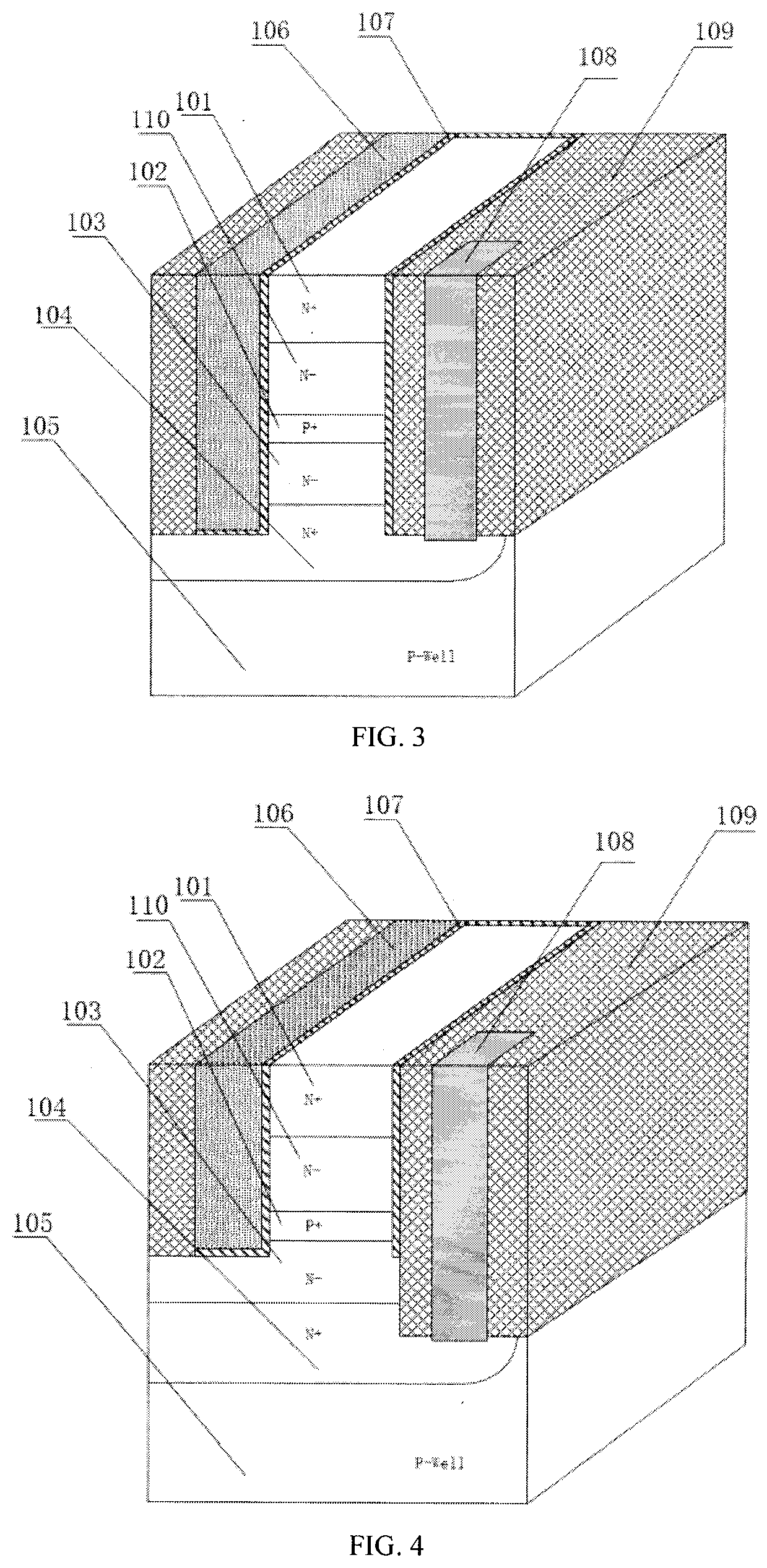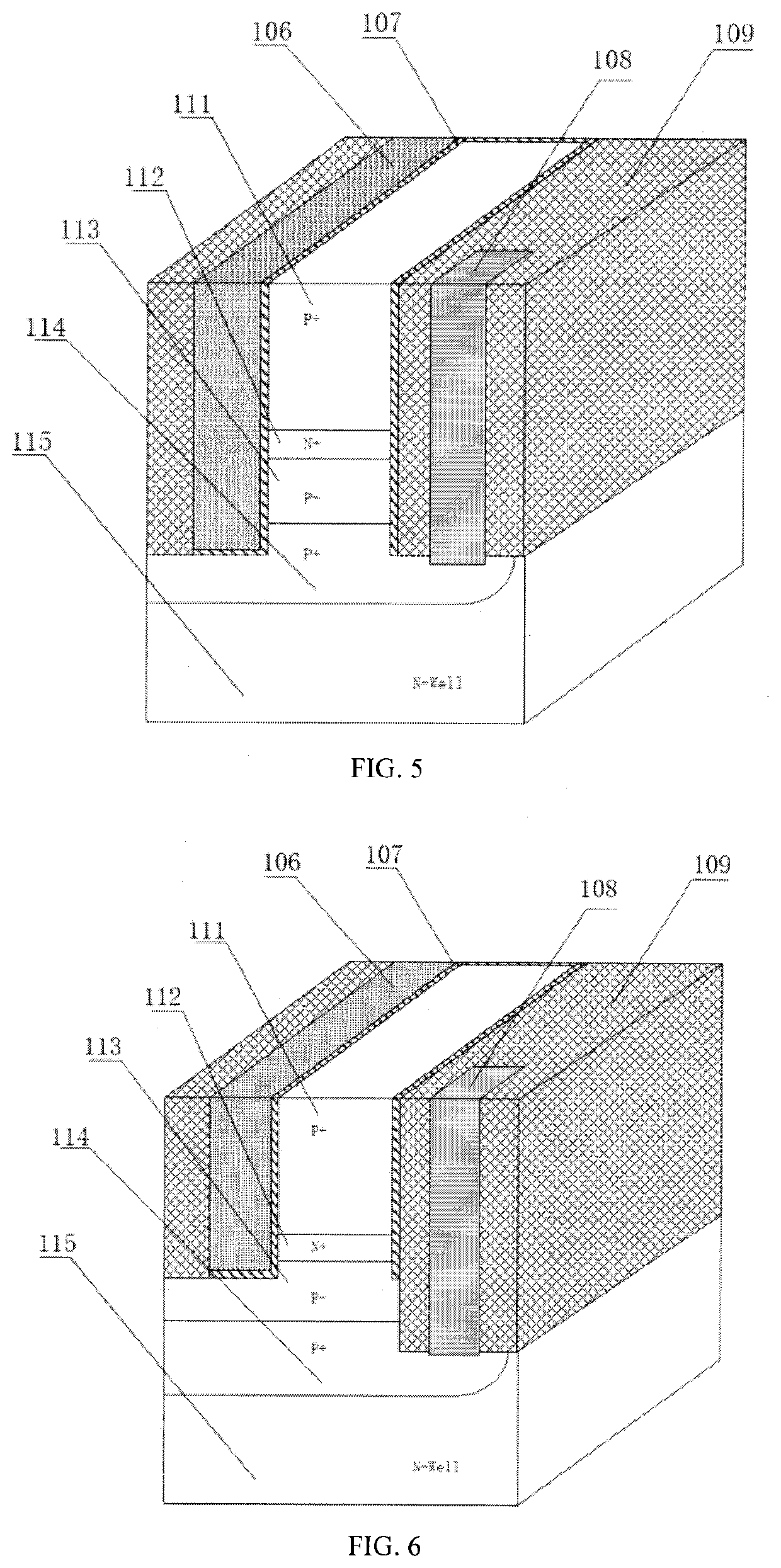Nano-wall Integrated Circuit Structure with High Integrated Density
a technology of integrated circuits and nano-walls, applied in the field of microelectronics technology and integrated circuits, can solve the problems of reducing integration, limiting the improvement of integration, and increasing the area of integrated circuits, so as to increase the driving capability of transistors, reduce the on-resistance ron, and reduce the effect of integration
- Summary
- Abstract
- Description
- Claims
- Application Information
AI Technical Summary
Benefits of technology
Problems solved by technology
Method used
Image
Examples
example 1
[0053]A computer three-dimensional simulation was performed based on the CMOS inverter structure using the technical embodiments 6 and 8 of this invention, and the simulation structure is shown in FIG. 14. For the NMOSFET, the N+ heavily doped source region is silicon, the depth or thickness is 20 nm, and the doping concentration is 1×1020 cm−3. The depth or thickness of the N− lightly doped source region is 20 nm, and the doping concentration is 1×1016 cm−3. The depth or thickness of the P+ channel region is 10 nm, and the doping concentration is 1×1018 cm−3. The depth or thickness of the N− lightly doped drain region is 20 nm, and the doping concentration is 1×1016 cm−3. The depth or thickness of the N+ heavily doped drain region is 20 nm, and the doping concentration is 1×1020 cm−3. For the PMOSFET, the depth or thickness of the P+ heavily doped source region is 20 nm, and the doping concentration is 1×1020 cm−3. The depth or thickness of the P− lightly doped source region is 20 ...
example 2
[0055]A computer three-dimensional simulation was performed based on the NMOSFET structure using the technical embodiment 4 of this invention, and the cross-sectional view of the simulation structure is shown in FIG. 16. The N+ heavily doped source region material is silicon, the depth or thickness is 10 nm, and the doping concentration is 1×1020 cm−3. The depth or thickness of the N− lightly doped source region is 20 nm, and the doping concentration is 1×1017 cm−3. The depth or thickness of the P+ channel is 0.543 nm, and the doping concentration is 2×1020 cm−3. The depth or thickness of the N− lightly doped drain region is 20 nm, and the doping concentration is 1×1017 cm−3. The depth or thickness of the N+ heavily doped drain region is 10 nm, and the doping concentration is 1×1020 cm−3. The gate material is polysilicon, and the depth is 2 nm below the bottom surface of the P+ channel region. The gate dielectric material is silicon dioxide with a thickness of 1.1 nm. The gate is ar...
example 3
[0057]A computer three-dimensional simulation was performed based on the NMOSFET structure using the technical embodiment 2 of this invention, and the cross-sectional view of the simulation structure is shown in FIG. 20. The N+ heavily doped source region material is SiGe, the depth or thickness is 10 nm, and the doping concentration is 1×1020 cm−3. The depth or thickness of the P+ channel is 7 nm, and the doping concentration is 5×1019 cm−3. The depth or thickness of the N− lightly doped drain region is 10 nm, and the doping concentration is 1×1015 cm−3. The depth or thickness of the N+ heavily doped drain region is 10 nm, and the doping concentration is 1×1020 cm−3. The gate material is polysilicon, and the depth is flush with the bottom surface of the P+ channel region. The gate dielectric material is silicon dioxide, and the thickness is 2 nm. The gate is arranged on three sides of the PN functional area, the corresponding channel width is 21 nm, and the channel width-to-length ...
PUM
| Property | Measurement | Unit |
|---|---|---|
| thickness | aaaaa | aaaaa |
| thickness | aaaaa | aaaaa |
| depth | aaaaa | aaaaa |
Abstract
Description
Claims
Application Information
 Login to View More
Login to View More - R&D
- Intellectual Property
- Life Sciences
- Materials
- Tech Scout
- Unparalleled Data Quality
- Higher Quality Content
- 60% Fewer Hallucinations
Browse by: Latest US Patents, China's latest patents, Technical Efficacy Thesaurus, Application Domain, Technology Topic, Popular Technical Reports.
© 2025 PatSnap. All rights reserved.Legal|Privacy policy|Modern Slavery Act Transparency Statement|Sitemap|About US| Contact US: help@patsnap.com



